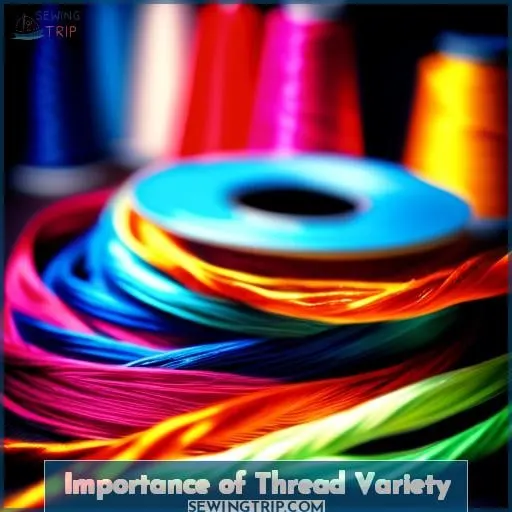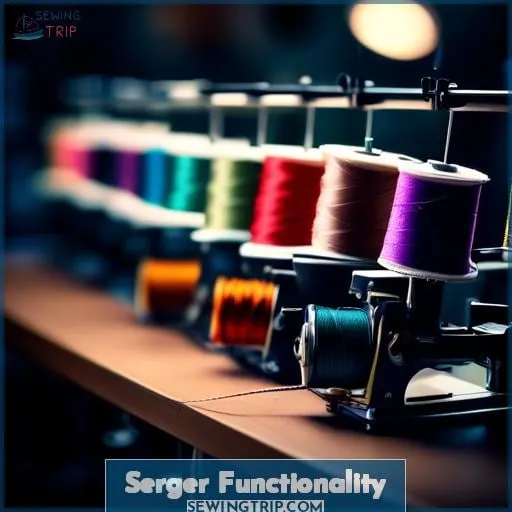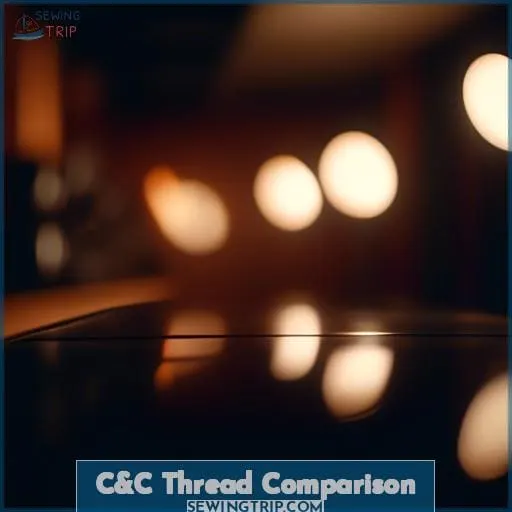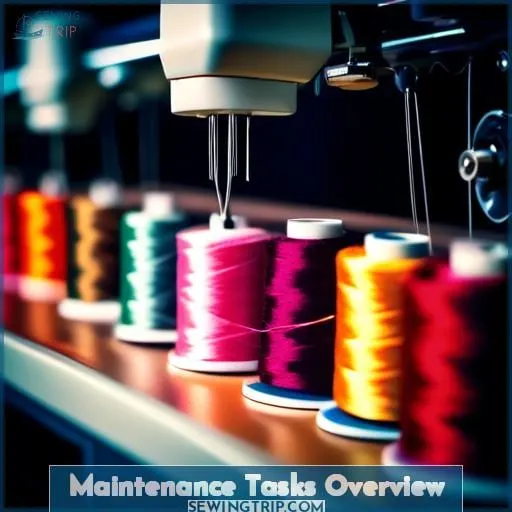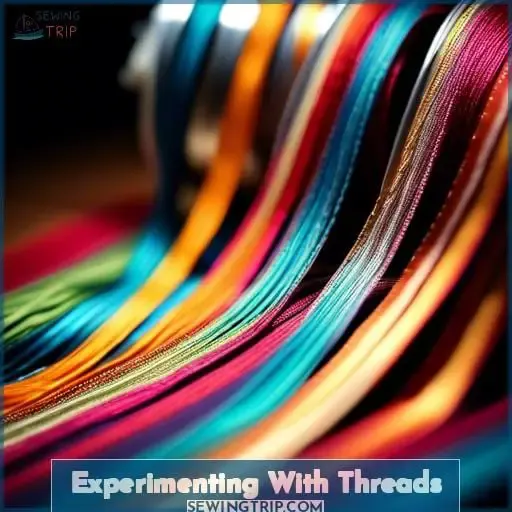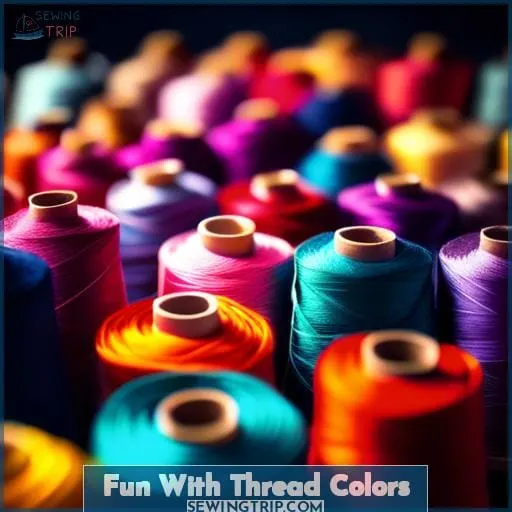This site is supported by our readers. We may earn a commission, at no cost to you, if you purchase through links.
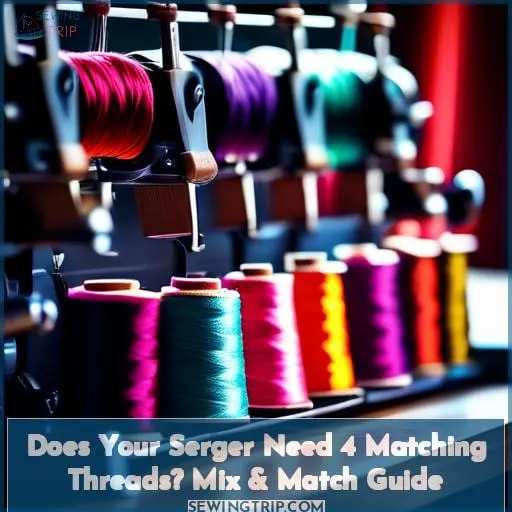
The truth is, while color-coordinated threads can give a clean, professional look, especially on visible seams, it’s not always necessary. Your serger can work with a variety of thread colors, which can be a cost-effective way to utilize your thread stash and can even aid in troubleshooting stitch issues.
Plus, experimenting with different thread colors can add a unique touch to your creations, allowing for personalization and creativity in your sewing endeavors.
No, a serger does not need to use 4 same color threads; only the thread in the outside needle typically shows on the final product.
Table Of Contents
- Key Takeaways
- Importance of Thread Variety
- Serger Functionality
- Color Harmony Considerations
- Maxilock Thread Versatility
- C&C Thread Comparison
- Serger Maintenance Benefits
- Maintenance Tasks Overview
- Extending Serger Lifespan
- Experimenting With Threads
- Fun With Thread Colors
- Frequently Asked Questions (FAQs)
- Conclusion
Key Takeaways
- Sergers do not require all four threads to be the same color; only the outside needle thread typically shows on the finished seam, allowing for flexibility in thread color choices.
- Using different thread colors can be a practical way to check stitch quality and serger functionality, especially for those learning how to use their serger.
- A basic thread palette of whites, neutrals, and darks can cover most serging projects, and using neutral colors in the loopers can save money and storage space.
- Quality threads are recommended for optimal serger performance, and for visible seams or decorative purposes, the thread color that matches or contrasts the fabric can be used in the outside needle position.
Importance of Thread Variety
Utilizing a variety of thread colors in your serger not only enhances the visual appeal of your projects but also serves practical purposes. Different thread colors can be strategically used to check the quality of stitches and ensure that your serger is functioning correctly.
For instance, using contrasting colors in the looper and needle threads can help you identify any tension issues or irregularities in the stitching, which can be crucial for maintaining the performance of your serger and the durability of your projects.
Moreover, having a selection of both light and dark threads allows for greater flexibility in matching or complementing the fabric you’re working with. Light colors like cream, light gray, white, light rose, and pale green can be used for lighter fabrics to avoid shadowing, while dark colors such as dark brown, dark green, dark gray, and dark blue are suitable for darker materials.
Serger Functionality
Your serger’s functionality extends beyond simple seam finishing; it’s a versatile tool that can create professional-quality edges and decorative effects quickly and efficiently. You’ll find that your serger can handle a variety of tasks with ease, from constructing durable seams to adding decorative touches with different thread colors and stitch types.
- Machine Compatibility: Ensure your serger is compatible with the accessories and threads you plan to use. This includes checking for the right serger coverstitch machine or serger fabric guide for your projects.
- Thread Quality and Budget Considerations: Invest in quality threads like Maxilock or C&C to reduce frustration and ensure optimal performance, while being mindful of your budget. Quality threads can prevent issues like puckering and thread breakage.
- Color Coordination and Scrap Fabric: Experiment with color coordination to achieve the desired aesthetic for your projects. Use scrap fabric to test out stitches and tension adjustments before committing to your final piece.
By paying attention to these details, you can maximize the potential of your serger, whether you’re working on a simple serger cover or exploring serger inspirational guides for new ideas. Remember, regular maintenance and proper tension adjustments are key to extending the lifespan and ensuring the smooth operation of your serger.
Color Harmony Considerations
When considering whether your serger needs 4 matching threads, it’s important to think about the visibility of the threads in your finished project.
Blending different colors can offer both aesthetic and functional benefits, allowing for creative decorative effects.
This approach can also be more cost-effective, making the most of your thread collection.
Thread Visibility Impact
When considering the impact of thread visibility on your serged projects, it’s important to recognize that the color of the thread in the outside needle position is the one that will be most visible on the finished seam.
Your serger’s color palette can include a variety of shades, allowing for stitch variety and creative expression. For practicality, consider bobbin winding to utilize smaller spools for needle positions.
Thread weight and the serger’s clear foot can influence the decorative effects achieved. Embrace serger money-saving tips, such as using multi-colored threads for internal seams, and consult serger books or a serger podcast sprint for further mastery.
Enjoy the process and the savings it brings.
Blending Technique Benefits
Blending different thread colors can enhance your serging projects by creating subtle or striking visual effects. By using creative thread combinations, you can achieve color contrast that complements the fabric’s hue, enhancing fabric texture and adding depth to your designs.
The hidden seam technique allows for a seamless look, while color wheel theory guides you in selecting thread colors that harmonize or stand out. This approach is cost-conscious as it maximizes the use of your thread stash without needing to match every fabric color exactly.
Decorative Possibilities
With the use of different thread colors on a serger, you can explore a range of decorative possibilities, from subtle harmonies to bold contrasts, enhancing the visual appeal of your projects. Maxilock and C&C threads offer diverse color choices for unique fabric effects in creative projects through fun experimentation.
- Diverse color choices
- Thread combinations for unique effects
- Creative projects with varied threads
- Fun experimentation with thread colors
- Enhancing visual appeal through color harmony
Maxilock Thread Versatility
Maxilock threads offer a wide range of colors and are known for their versatility, making them a suitable choice for both decorative and functional purposes in serging.
They’re compatible with sergers and are available in both light and dark shades, which can be used to create harmonious color schemes or to check the quality of stitches during serging.
The threads are also noted for their strength and durability, which is essential for the high-speed operation of sergers. Users have reported positive experiences with Maxilock threads for various sewing projects, including those that require frequent laundering and long-term use.
It’s recommended to experiment with different thread colors to achieve unique effects and to ensure the serger is regularly maintained for optimal performance.
C&C Thread Comparison
When transitioning from discussing Maxilock thread versatility to comparing C&C threads, one might wonder, why should you consider C&C threads for your serger projects?
C&C thread advantages include their availability and the range of colors they offer, which can be particularly appealing if you’re looking to match or complement fabric colors precisely.
While some users have found C&C thread pricing to be higher compared to other brands, the quality of C&C threads can justify the cost, especially if you’re aiming for a specific look or working with materials that require a stronger thread.
Moreover, C&C thread quality has been satisfactory for many users, with no reported issues on sergers, suggesting that these threads can be a reliable choice for both functional and decorative purposes.
It’s also worth noting that C&C threads come in a variety of weights, which can be advantageous when working on different types of projects.
Experimenting with C&C thread color range can lead to unique and visually appealing results, adding another dimension to your serging projects.
Serger Maintenance Benefits
Maintaining your serger is key to its longevity and performance. Regular care, such as cleaning and oiling, can prevent issues that may arise from neglect.
By following these simple steps, you’ll save money in the long run and keep your serger running smoothly.
Extending Serger Lifespan
To ensure your serger operates smoothly for years to come, you’ll need to commit to regular maintenance, which can significantly extend its lifespan.
- Clean Regularly: Dust and lint can accumulate quickly. Make it a habit to brush out the lint after each project to prevent buildup that can affect performance.
- Oil as Directed: Consult your manual for specific oiling instructions. Proper lubrication ensures smooth operation and can prevent wear and tear.
- Replace Needles Often: Dull or damaged needles can harm fabric and strain the machine. Changing needles regularly maintains stitch quality and machine durability.
Maintenance Tasks Overview
You’ll need to perform regular maintenance on your serger to keep it running smoothly and extend its lifespan. Following the manufacturer’s guidelines, start with lint removal after each project to prevent buildup that can affect performance.
Oiling your serger, as specified in the manual instructions, ensures its parts move freely and reduces wear. Regular needle replacement is crucial; dull or damaged needles can ruin fabric and affect stitch quality.
Adhering to these steps not only upholds the serger’s functionality but also safeguards your investment. By being diligent with maintenance, guided by the manual’s instructions, you’ll master your serger’s upkeep, ensuring it remains a reliable tool for your creative endeavors.
Extending Serger Lifespan
Extending the serger lifespan involves regular maintenance and proper care to ensure optimal performance and longevity.
To keep your serger running smoothly, it’s crucial to select high-quality threads that won’t stress the machine’s components. Bargain threads may seem cost-effective, but they can lead to frustration and damage, affecting serger efficiency.
Regularly cleaning the lint filter, oiling the machine, and replacing needles as needed are essential tasks that contribute to machine longevity.
By investing time in these maintenance activities, you not only enhance serger performance but also prevent potential problems that could shorten the serger’s life.
Experimenting With Threads
Transitioning from extending the serger lifespan, let’s delve into the exciting realm of experimenting with threads on your serger.
With a versatile color palette at your disposal, you have the opportunity to explore decorative thread choices and unleash your creativity. Embrace the mix and match guide to thread color harmony, allowing you to craft unique and visually appealing projects.
Serger thread experimentation opens doors to a world of possibilities, where each stitch tells a story of your artistry. By daring to venture beyond conventional norms, you can elevate your sewing endeavors to new heights.
So, grab those threads, blend them with finesse, and let your serger sing with a symphony of colors that reflect your style and imagination.
Fun With Thread Colors
Exploring the vibrant world of serger thread colors can elevate your sewing projects from functional to fantastic. By carefully considering thread color placement, thread weight variation, and texture combinations, you can introduce a new level of creativity and precision to your work.
Experimenting with different thread brands and decorative stitching techniques also opens up a world of possibilities for customization and flair.
- Joy in Creation: Discover the satisfaction of creating unique, visually appealing projects that reflect your personal style.
- Mastery of Technique: Gain confidence and skill as you learn to manipulate thread colors, weights, and textures for optimal results.
- Cost-Effective Customization: Save money by transforming simple materials into high-quality, customized pieces through strategic thread use and decorative techniques.
Frequently Asked Questions (FAQs)
How does the type of fabric being serged influence the choice of thread color?
The type of fabric you’re serging greatly influences your thread color choice. For visible seams or competitive projects, match thread colors closely to your fabric.
For internal seams or less visible areas, you can be more flexible. This allows you to use neutrals or multi-colored threads to save costs and simplify your thread inventory.
Can using different weights of thread in the serger affect the final stitch quality?
Using different weights of thread in your serger can indeed affect the final stitch quality.
Heavier threads can create more pronounced textures, while finer threads blend better and create flatter seams.
Adjust tension accordingly to prevent issues like puckering or looping.
What are the environmental impacts of using synthetic serger threads versus natural fiber threads?
Synthetic serger threads, like plastic in the ocean, linger longer in the environment than natural fibers. They’re cheaper but carry a heavier ecological footprint, urging a stitch in time for sustainability.
How do you determine the right thread tension when using threads of varying colors?
To determine the right thread tension when using threads of varying colors, start by threading your serger with different colored threads, ensuring correct threading order.
Set all tension dials to the midpoint of the suggested range, usually around ‘4’. Serge on scrap fabric, then adjust tensions one at a time, evaluating the stitch formation.
The looper threads should meet at the fabric’s edge, and needle threads should appear as straight lines on the right side and small dots on the wrong side.
Are there any specific techniques for threading a serger to achieve a multicolored seam effect?
To achieve a multicolored seam effect on your serger, thread each of the serger’s positions with different colored threads.
Start by threading the upper looper, followed by the lower looper, then the right needle, and finally the left needle.
This setup allows you to experiment with various color combinations and effects in your projects, adding a unique touch to your creations.
Conclusion
Imagine your serger as a painter’s palette, where threads of different colors blend to create a unique fabric tapestry.
You don’t need to stick to four matching threads; mix and match to suit your project’s needs and your budget.
Embrace the versatility of your serger, maintain it well to extend its lifespan, and let your creativity flow.

